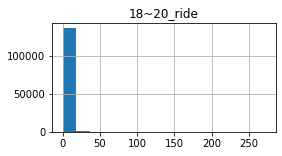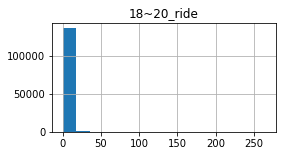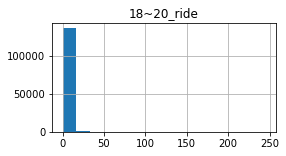[Dacon] 제주 퇴근시간 버스 승하차 인원 예측 3 - modeling
업데이트:
개요

이번 포스팅에서는 지난 feature engineering 포스팅에 이어서 여러가지 머신러닝 알고리즘을 적용해서, 최종 산출물을 내보기로 한다.
(미완성)
Modeling
import pandas as pd
import warnings
warnings.filterwarnings(action='ignore')
import numpy as np
import os
from sklearn.model_selection import StratifiedShuffleSplit
from sklearn.model_selection import train_test_split
from sklearn.ensemble import RandomForestRegressor
from sklearn.metrics import mean_squared_error
from sklearn.preprocessing import MinMaxScaler, StandardScaler
from sklearn.model_selection import ParameterGrid, StratifiedKFold, KFold
from sklearn.tree import DecisionTreeRegressor
from sklearn.tree import export_graphviz
from graphviz import Source
from sklearn.model_selection import GridSearchCV
from sklearn.model_selection import cross_val_score
import xgboost
os.chdir(r"D:\Python\dacon_bus_inout\result\\")
print("path: "+ os.getcwd())
print(os.listdir())
path: D:\Python\dacon_bus_inout\result
['regression.dot', 'result_interval.csv', 'result_interval_5_120.csv', 'rf_test_1.csv', 'test_r_set.csv', 'train_r_set.csv', 'xgb_test_1.csv']
# dir_ = ""
train = pd.read_csv("../result/train_r_set.csv", sep='|', encoding='cp949')
test = pd.read_csv("../result/test_r_set.csv", sep='|', encoding='cp949')
print("train :", len(train))
print("test :", len(test))
train : 415423
test : 228170
추가 작업을 시행
- 요일변수 one-hot encoding, 월~일 dummy랑 공휴일만남김
train[['mon','tue','wed','thr','fri','sat','sun']] = pd.get_dummies(train['dayofweek'])
test[['mon','tue','wed','thr','fri','sat','sun']] = pd.get_dummies(test['dayofweek'])
- 승객 유형 sum
train['미성년자'] = train[['어린이','청소년']].sum(axis=1)
train['기타'] = train[['장애일반', '장애동반', '유공일반', '유공동반']].sum(axis=1)
test['미성년자'] = test[['어린이','청소년']].sum(axis=1)
test['기타'] = test[['장애일반', '장애동반', '유공일반', '유공동반']].sum(axis=1)
x_dummy_cols = [
'mon', 'tue', 'wed', 'thr', 'fri', 'sat', 'sun', 'holiday',
#'일반', '어린이', '청소년','경로', '장애일반', '장애동반', '유공일반', '유공동반',
'일반', '미성년자','기타',
'in_out_new',
]
x_cols = [
'6~7_ride', '7~8_ride', '8~9_ride','9~10_ride', '10~11_ride', '11~12_ride',
'6~7_takeoff', '7~8_takeoff','8~9_takeoff', '9~10_takeoff', '10~11_takeoff','11~12_takeoff',
#'ride_1','ride_2', 'takeoff_1', 'takeoff_2',
'travel_time',
#'all_cnt', 'rule_cnt',
#'min_interval_m',
'mean_interval_m',
'loc_distance',
'강수_mn', '강수_ev', '기온_mn', '기온_ev',
'습도_mn', '습도_ev', '지면온도_mn', '지면온도_ev',
'풍속_mn', '풍속_ev'
]
y_col = ['18~20_ride']
X_train = train[x_cols + x_dummy_cols]
y_train = train[y_col]
X_test = test[x_cols + x_dummy_cols]
1. Scaling
- dummy변수들은 제외하고 스케일링(독립변수만, 표준화로)진행
def scaler(df, opt='standard'):
if opt=='standard':
scale = StandardScaler()
elif opt=='minmax':
scale = StandardScaler()
scale.fit(df)
return scale.transform(df)
X_train[x_cols] = scaler(X_train[x_cols], opt='standard')
X_test[x_cols] = scaler(X_test[x_cols], opt='standard')
2. Sampling method
계층적 k겹 샘플링(startified Kfold Sampling)
주로 분류문제에서 불균형 데이터에 대한 샘플링 방법으로, Random sampling보다 효율적
타깃 레이블의 전체 대비 비율(분포?)을 유지해주면서 sampling해줌(회귀문제에선 아직 잘 모르겠다.)
skfolds = StratifiedKFold(n_splits=3,shuffle=True, random_state=208) # 계층적 k겹 표본추출
for train_index, test_index in skfolds.split(X_train, y_train):
y_train.loc[test_index].hist(bins=15, figsize=(4,2))



위와 같이 0~1이 대부분인 불균형 데이터에 대하여, 분포를 유지한채 3겹으로 샘플링 해주었다.
단순 랜덤표본 추출보다는 검증단계에서 일반화의 오류에 빠지지 않을 수 있을 것 같다.
kfolds = KFold(n_splits=10, shuffle=True, random_state=208) # 기본 k겹
skfolds = StratifiedKFold(n_splits=10,shuffle=True, random_state=208) # 계층적 k겹 표본추출
3. Model Selection
이전에 공부했었던 모델을 바탕으로 적용해보려고 했다.
CART알고리즘을 기본으로 하는 Descision Tree와 Tree의 앙상블 모델인 Random Foreset, xgboost를 활용했다.
자세한 내용은 이전에 포스팅했었던 위의 링크를 타고 가면 된다.
3-1. Tree
Parameter
max_depth: default는 None으로 최대 깊이까지 학습(과대적합 가능성이 크므로 제한 주기)min_samples_split: 분할되기 위해 노드가 가져야하는 최소 샘플 수min_samples_leaf: 리프 노드가 가져야할 최소 샘플 수min_weight_fraction_leaf: min_samples_leaf와 같지만 가중치가 부여된 전체 샘플 수에서의 비율max_leaf_nodes: 리프 노드의 최대 수max_features: 각 노드에서 분할에 사용할 변수의 최대 수
(예시)
tree_reg = DecisionTreeRegressor(max_depth = 3,
random_state=208)
tree_reg.fit(X_train,y_train)
DecisionTreeRegressor(criterion='mse', max_depth=3, max_features=None,
max_leaf_nodes=None, min_impurity_decrease=0.0,
min_impurity_split=None, min_samples_leaf=1,
min_samples_split=2, min_weight_fraction_leaf=0.0,
presort=False, random_state=208, splitter='best')
export_graphviz(tree_reg, # 모델
out_file= "regression.dot", # 저장경로 설정
feature_names=X_train.columns, # 변수명
rounded = True, # 시각화(둥근네모)
filled = True) # 시각화(도형채우기)
Source.from_file("regression.dot")
Cross validation
- 파라미터 조정 & 샘플링 방식 변경
- 성능 별로
tree_reg = DecisionTreeRegressor(
max_features=7,
min_samples_leaf=5,
min_samples_split=10,
random_state=208
)
for cv_ in [kfolds, skfolds, 10]:
scores = cross_val_score(tree_reg, X_train, y_train,
scoring = "neg_mean_squared_error",
cv=cv_)
print("="*5 + type(cv_).__name__ + "="*5 )
rmse_scores = np.sqrt(-scores)
print("Scores :", rmse_scores)
print("Mean_rmse : " + str(round(np.mean(rmse_scores))))
print("std_rmse : " + str(round(rmse_scores.std(),6)))
print("\n")
=====KFold=====
Scores : [4.05982928 3.87923825 3.51923216 3.70645787 3.79507228 3.74208049
4.02201001 3.99998843 3.78494707 3.79464265]
Mean_rmse : 4.0
std_rmse : 0.15655
=====StratifiedKFold=====
Scores : [3.76005063 3.73618522 4.26605397 3.79848926 3.57092759 3.79810131
3.78032787 3.66075359 3.90525961 3.5891629 ]
Mean_rmse : 4.0
std_rmse : 0.186775
=====int=====
Scores : [3.86960502 3.86039245 3.46305275 3.92941261 4.31557629 4.23666014
3.26850242 4.46365827 3.45973618 3.34699524]
Mean_rmse : 4.0
std_rmse : 0.404305
3-2. ensemble - RandomForest
- RandomForest는 배깅(복원추출방식)을 적용한 Tree의 앙상블 모델
- Tree Parameter 그대로 갖고 있고, 몇개의 Tree를 쓸건지(n_estimators) 지정
rf_reg = RandomForestRegressor(
n_estimators=50,
max_features=7,
min_samples_leaf=5,
min_samples_split=10,
n_jobs=4,
random_state=208
)
scores = cross_val_score(rf_reg, X_train, y_train,
scoring = "neg_mean_squared_error",
cv=kfolds)
print("="*5 + type(cv_).__name__ + "="*5 )
rmse_scores = np.sqrt(-scores)
print("Scores :", rmse_scores)
print("Mean_rmse : " + str(round(np.mean(rmse_scores))))
print("std_rmse :", rmse_scores.std())
print("\n")
=====int=====
Scores : [3.42606352 3.12660157 2.8999335 3.065909 3.09069948 3.27700777
3.13008307 3.30502241 3.18308162 2.82462897]
Mean_rmse : 3.0
std_rmse : 0.17160329885446585
rf_reg.fit(X_train, y_train)
sub_df = pd.read_csv('../data/submission_sample.csv')
sub_df['18~20_ride'] = rf_reg.predict(X_test)
sub_df.to_csv('rf_basic_1.csv', index = False)
3-3. ensemble - Xgboost
CART알고리즘을 활용하는 결국 RandomForest의 부류인 부스팅 알고리즘
- 이전 모델이 만든 잔여오차(residual error)에 새로운 모델을 학습(그래디언트 부스팅(Gradient Boosting)을 기반)
- (배깅은 개별 모델들의 예측값을 마지막에 집계만 함)
- 1모델로 학습 -> 잔여오차로 2모델 학습 -> 잔여오차로 3모델 학습 … (새로운 샘플이 들어왔을때 각 모델의 예측값의 sum)
st_sampling = StratifiedShuffleSplit(n_splits=1, test_size = 0.1, random_state= 42)
X_train_t, X_val = train_test_split(X_train, test_size = 0.2, random_state=208)
y_train_t, y_val = train_test_split(y_train, test_size = 0.2, random_state=208)
xgb_reg=xgboost.XGBRegressor(booster='gbtree',
colsample_bylevel=0.9,
colsample_bytree=0.8,
gamma=0,
max_depth=10,
min_child_weight=3,
n_estimators=250,
nthread=4,
objective='reg:linear',
random_state=208)
xgb_reg.fit(X_train_t,y_train_t,
eval_set=[(X_val,y_val)],
eval_metric = 'rmse',
early_stopping_rounds=100)
[16:35:54] WARNING: C:/Jenkins/workspace/xgboost-win64_release_0.90/src/objective/regression_obj.cu:152: reg:linear is now deprecated in favor of reg:squarederror.
[0] validation_0-rmse:4.77293
Will train until validation_0-rmse hasn't improved in 100 rounds.
[1] validation_0-rmse:4.55417
[2] validation_0-rmse:4.34637
[3] validation_0-rmse:4.16387
[4] validation_0-rmse:4.01638
[5] validation_0-rmse:3.8933
[6] validation_0-rmse:3.77621
[7] validation_0-rmse:3.6645
[8] validation_0-rmse:3.57037
[9] validation_0-rmse:3.49774
... 중략
[242] validation_0-rmse:2.85568
[243] validation_0-rmse:2.85588
[244] validation_0-rmse:2.85546
[245] validation_0-rmse:2.85545
[246] validation_0-rmse:2.8554
[247] validation_0-rmse:2.85492
[248] validation_0-rmse:2.85469
[249] validation_0-rmse:2.85441
XGBRegressor(base_score=0.5, booster='gbtree', colsample_bylevel=0.9,
colsample_bynode=1, colsample_bytree=0.8, gamma=0,
importance_type='gain', learning_rate=0.1, max_delta_step=0,
max_depth=10, min_child_weight=3, missing=None, n_estimators=250,
n_jobs=1, nthread=4, objective='reg:linear', random_state=208,
reg_alpha=0, reg_lambda=1, scale_pos_weight=1, seed=None,
silent=None, subsample=1, verbosity=1)
sub_df = pd.read_csv('../data/submission_sample.csv')
sub_df['18~20_ride'] = xgb_reg.predict(X_test)
sub_df.to_csv('xgb_test_1.csv', index = False)
4. Parameter Tunning
4-1. gridSearch - RandomForest
param_grid = [
{'n_estimators': [200, 300, 400],
'max_features': [5, 8],
'min_samples_leaf':[1],
'min_samples_split':[2]},
{'bootstrap': [False], # 비복원추출
'n_estimators': [150, 200, 250],
'max_features': [5, 8],
'min_samples_leaf':[1],
'min_samples_split':[2]}
]
skfolds = StratifiedKFold(n_splits=10, random_state=208)
rf_reg = RandomForestRegressor(random_state=208)
grid_search = GridSearchCV(rf_reg,
param_grid,
cv = skfolds,
n_jobs=4,
scoring='neg_mean_squared_error',
return_train_score=True,
verbose=2)
grid_search.fit(X_train, y_train)
print(grid_search.best_params_)





댓글남기기